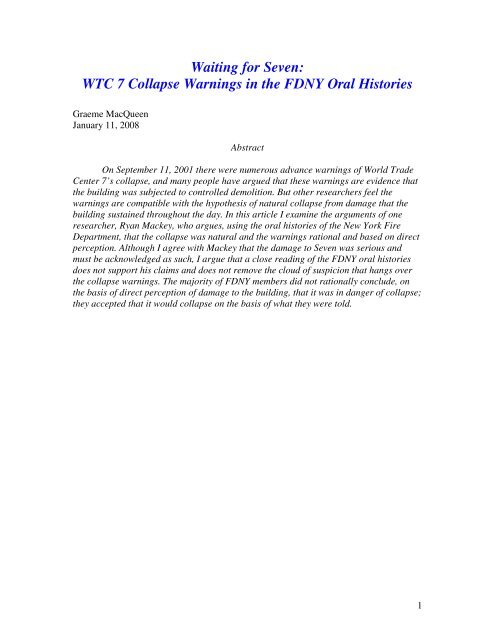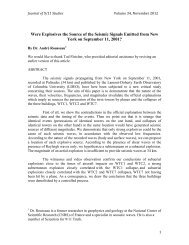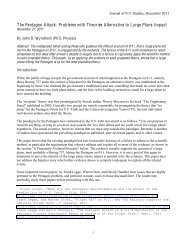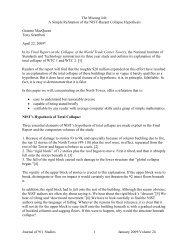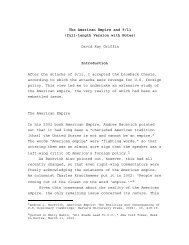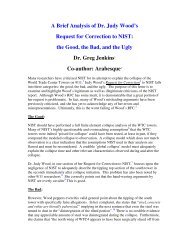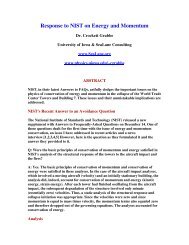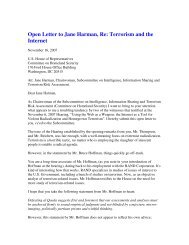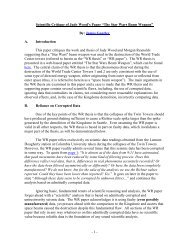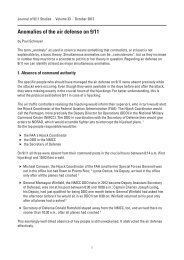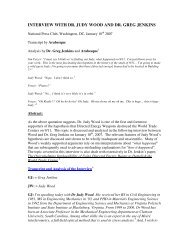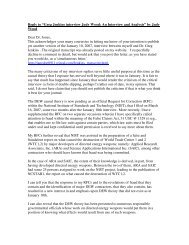Waiting for Seven - Journal of 9/11 Studies
Waiting for Seven - Journal of 9/11 Studies
Waiting for Seven - Journal of 9/11 Studies
You also want an ePaper? Increase the reach of your titles
YUMPU automatically turns print PDFs into web optimized ePapers that Google loves.
<strong>Waiting</strong> <strong>for</strong> <strong>Seven</strong>:<br />
WTC 7 Collapse Warnings in the FDNY Oral Histories<br />
Graeme MacQueen<br />
January <strong>11</strong>, 2008<br />
Abstract<br />
On September <strong>11</strong>, 2001 there were numerous advance warnings <strong>of</strong> World Trade<br />
Center 7’s collapse, and many people have argued that these warnings are evidence that<br />
the building was subjected to controlled demolition. But other researchers feel the<br />
warnings are compatible with the hypothesis <strong>of</strong> natural collapse from damage that the<br />
building sustained throughout the day. In this article I examine the arguments <strong>of</strong> one<br />
researcher, Ryan Mackey, who argues, using the oral histories <strong>of</strong> the New York Fire<br />
Department, that the collapse was natural and the warnings rational and based on direct<br />
perception. Although I agree with Mackey that the damage to <strong>Seven</strong> was serious and<br />
must be acknowledged as such, I argue that a close reading <strong>of</strong> the FDNY oral histories<br />
does not support his claims and does not remove the cloud <strong>of</strong> suspicion that hangs over<br />
the collapse warnings. The majority <strong>of</strong> FDNY members did not rationally conclude, on<br />
the basis <strong>of</strong> direct perception <strong>of</strong> damage to the building, that it was in danger <strong>of</strong> collapse;<br />
they accepted that it would collapse on the basis <strong>of</strong> what they were told.<br />
1
In the debate over the collapse <strong>of</strong> World Trade Center 7, warnings <strong>of</strong> the<br />
building’s collapse have come to play an important role. In addition to the numerous<br />
collapse warnings mentioned in written documents such as those I will be using in this<br />
article, we have seen a growing number <strong>of</strong> videotape fragments and interviews in which<br />
people appear to have been told in advance <strong>of</strong> <strong>Seven</strong>’s collapse.[1] Many proponents <strong>of</strong><br />
the controlled demolition hypothesis take these cases, both written and video, as evidence<br />
that the building’s collapse was brought about deliberately. How could people have<br />
suspected or even known with certainty hours in advance that the building was going to<br />
collapse if this collapse was not under human control? These arguments typically try to<br />
place the event in historical context, stressing how unusual it was <strong>for</strong> a steel-framed<br />
skyscraper to undergo this kind <strong>of</strong> total collapse, whether from fire or from other possible<br />
causes. In this way they stress the peculiarity and the suspect nature <strong>of</strong> the advance<br />
warnings.<br />
But those who think that <strong>Seven</strong>’s fall was natural rather than deliberate have not<br />
shied away from the collapse warnings. They have simply interpreted them in a different<br />
way. In essence, they have said that the warnings were rational and expected given the<br />
severe damage <strong>Seven</strong> had sustained. These researchers may even consider collapse<br />
warnings, when combined with other factors, as evidence positively favouring the<br />
hypothesis <strong>of</strong> natural (non-demolition) collapse.<br />
Mark Roberts, <strong>for</strong> example, has set <strong>for</strong>th a detailed collection <strong>of</strong> collapse<br />
warnings, many <strong>of</strong> which are drawn from the oral histories <strong>of</strong> the New York Fire<br />
Department, [2] and has tried to use these to support his hypothesis <strong>of</strong> a natural<br />
collapse.[3] Ryan Mackey has used this material in a similar fashion.[4] Since I find<br />
Mackey’s reasoning more clear than Roberts’ I will take him in this paper as<br />
representative <strong>of</strong> this position.<br />
Here are four <strong>of</strong> Mackey’s comments on the issue. All quotations are taken from<br />
his recent and lengthy monograph criticizing David Ray Griffin’s book, Debunking 9/<strong>11</strong><br />
Debunking.[5]<br />
I. “Based on these numerous, corroborating accounts, coupled with video <strong>of</strong> the fires in<br />
WTC 7 and the fact that it burned <strong>for</strong> over six hours, there is indeed a better explanation<br />
than explosives <strong>for</strong> why the collapse was expected. There is some disagreement between<br />
firefighter accounts about exactly how many floors were burning or how intensely, but<br />
there can be no dispute that the fire persisted <strong>for</strong> hours, that the structure weakened, or<br />
that firefighters believed on this basis that the structure was likely to collapse.”<br />
II. “Dr. Griffin is faced with a difficult problem. He is attempting to equate prediction <strong>of</strong><br />
the collapses with conspiracy to demolish WTC 7, or at the very least cognizance there<strong>of</strong>.<br />
As numerous accounts indicate, both in <strong>of</strong>ficial interviews and ordinary reporting, the<br />
FDNY collectively knew that WTC 7 was in danger <strong>of</strong> collapse hours be<strong>for</strong>e it finally<br />
fell. If Dr. Griffin wishes to maintain his theory, then he must make a painful choice:<br />
1. Accept that the FDNY was part <strong>of</strong> the plot to destroy WTC 7.<br />
2. Accept that the FDNY knew <strong>of</strong> the plot, but did nothing to stop it, and to this day<br />
refuses to talk about it.<br />
3. Propose that someone “in the know” tricked a high-ranking member <strong>of</strong> the FDNY<br />
into thinking that it would collapse, and:<br />
a. This duped individual convinced many more firefighters that it would<br />
collapse;<br />
b. Those so in<strong>for</strong>med believed it would collapse;<br />
2
c. Not a single FDNY member expressed doubts about what they were told,<br />
based on their own experience and the actual condition <strong>of</strong> WTC 7; and<br />
d. The structure burned and showed unmistakable signs <strong>of</strong> weakening anyway.<br />
All <strong>of</strong> these three choices suggest (and insultingly so) highly unlikely behavior on the<br />
part <strong>of</strong> the firefighters. None has the slightest support in evidence. The rational<br />
conclusion, again, is that their training and observation led them to conclude, correctly,<br />
that WTC 7 was in danger <strong>of</strong> collapsing.”<br />
III. “In summary, the ‘unique features’ <strong>of</strong> WTC 7’s collapse are completely logical, and<br />
were obvious to the rescue workers on site. Dr. Griffin’s suspicions, namely that the<br />
knowledge <strong>of</strong> collapse and more rapid removal <strong>of</strong> debris is pro<strong>of</strong> <strong>of</strong> a conspiracy to<br />
destroy WTC 7, has no grounding in reality.”<br />
IV. “From the firefighter comments, there are a few elements common to virtually every<br />
single account that must be considered as credible:<br />
• Fires persisted from the WTC 1 debris impacts up to the final collapse <strong>of</strong> WTC 7<br />
• Fires were present on multiple floors<br />
• Fires were considered a threat to the building’s structural integrity<br />
It is the third point that poses the biggest problem to Dr. Griffin’s theory. Not one<br />
firefighter interview expresses doubt or surprise at the collapse <strong>of</strong> WTC 7, even though<br />
accounts do differ in other details.”<br />
Be<strong>for</strong>e turning to Mackey’s central argument, I want to draw attention to two<br />
distinctions I believe he ought to have made more clearly, the distinction between<br />
certainty and uncertainty in a collapse warning, and the distinction between early and late<br />
warnings. These distinctions seem to me to be very important. To take extreme examples:<br />
if someone sees a building that has been burning <strong>for</strong> hours and is manifesting various<br />
signs <strong>of</strong> damage and says, “I’m worried about the possibility that this building might<br />
collapse, so I’m going to establish a safety zone around this building” this is quite<br />
different from someone saying hours earlier when damage is much lighter, “I know <strong>for</strong> a<br />
certainty that, later on today, this building will collapse.” The second case invites much<br />
more skepticism about natural collapse than the first.<br />
But let us return to Mackey. What is his argument? I believe the main points are<br />
as follows:<br />
1. Building <strong>Seven</strong> was seriously damaged early in the day and this damage<br />
progressed as the day went on.<br />
2. FDNY members at the scene, whose testimony has been preserved, directly<br />
perceived this damage.<br />
3. These FDNY members rationally concluded from what they perceived that the<br />
building was in danger <strong>of</strong> collapse.<br />
4. The collapse warnings in the FDNY collection are merely the manifestation <strong>of</strong><br />
this rational conclusion.<br />
I will focus on statements three and four in this article.<br />
3
Mackey speaks, in his monograph, in support <strong>of</strong> the following principle,<br />
consistent with the scientific method: “Claims that can be verified, either through<br />
calculation and experiment or independent confirmation, are the most valuable (and you<br />
should consider verifying them yourself, if you are able).” [7] This is a good principle,<br />
and in keeping with it I have investigated five questions in relation to the FDNY oral<br />
histories:<br />
(1) In the FDNY oral histories, how many FDNY members report hearing warnings <strong>of</strong><br />
<strong>Seven</strong>’s collapse?<br />
(2) What was the degree <strong>of</strong> certainty in these warnings? If we create a binary system,<br />
how many firefighters can we classify as hearing that that the building might come down<br />
and how many can we classify as hearing that it would come down?<br />
(3) To the extent that we can determine times from the testimonies, how long be<strong>for</strong>e the<br />
actual collapse were the warnings received?<br />
(4) Who ascertained that the building was headed <strong>for</strong> possible or certain collapse—the<br />
FDNY members reporting the warnings or other parties such as their <strong>of</strong>ficial superiors?<br />
(5) How many FDNY members gave causes <strong>of</strong> the expected collapse and what causes did<br />
they identify?<br />
My method <strong>of</strong> answering these questions has been the old-fashioned one <strong>of</strong><br />
reading the FDNY oral histories in their entirety. We can find most references through<br />
directed computer searches, but inevitably some cases slip through.<br />
Although there is some degree <strong>of</strong> subjectivity in the decision as to what cases to<br />
include and how to classify cases, Appendices A and B represent my best attempts.<br />
Appendix A lists the witnesses and Appendix B records my coding <strong>of</strong> each case. Please<br />
note that these lists and tables do not attempt to capture all references to damage to <strong>Seven</strong><br />
and even less do they claim to capture all references to building <strong>Seven</strong> in the oral<br />
histories. They deal only with collapse warnings.<br />
On the basis <strong>of</strong> the findings summarized in these appendices, the five questions<br />
posed may now be answered.<br />
(1) In the FDNY oral histories, there are about 60 FDNY members who report hearing<br />
warnings <strong>of</strong> <strong>Seven</strong>’s collapse.<br />
(2) Of these 60 cases, only two have an unknown degree <strong>of</strong> certainty. Thirty-one cases<br />
qualify as “definite” (<strong>Seven</strong> is thought definitely to be coming down), while 27 qualify as<br />
“indefinite” (<strong>Seven</strong> might come down).<br />
(3) In 27 cases time could not be determined. Of the remaining cases, 17 warnings were<br />
received less than two hours be<strong>for</strong>e collapse, while ten were received two or more hours<br />
be<strong>for</strong>e collapse and six appear to have been received four or more hours be<strong>for</strong>e collapse.<br />
(4) In five cases it is unknown who ascertained that the building was headed <strong>for</strong> possible<br />
or certain collapse. Of the remaining cases, seven FDNY members personally ascertained<br />
or affirmed the possible or definite collapse, while in 50 cases this judgment was made by<br />
others, typically <strong>of</strong>ficial superiors. (There are two cases where the judgment was made on<br />
the basis <strong>of</strong> both self and other—hence the failure <strong>of</strong> these numbers to add up to the<br />
correct total.)<br />
4
(5) In 38 cases no cause <strong>of</strong> collapse is given. Of the remaining cases, no member gives<br />
other (non-fire) damage as sole cause <strong>of</strong> collapse; 15 members give fire alone as cause <strong>of</strong><br />
collapse; and seven members give a combination <strong>of</strong> fire and other damage as cause <strong>of</strong><br />
collapse.<br />
Be<strong>for</strong>e turning directly to Mackey’s argument, I note that almost half <strong>of</strong> the<br />
warnings where time can be estimated were received over two hours in advance <strong>of</strong> the<br />
building’s collapse, and I also note that over half <strong>of</strong> the total collapse warnings are<br />
definite (we are dealing with more than suspicions and worries and estimates). These<br />
findings put a burden on any hypothesis <strong>of</strong> natural collapse.<br />
But let us turn to the third statement I listed in my summary <strong>of</strong> Mackey’s<br />
argument. Is it true that FDNY members rationally concluded from what they perceived<br />
that the building was in danger <strong>of</strong> collapse? Only seven appear to have done so, whereas<br />
50 accepted the collapse prediction from others, typically superiors.<br />
With regard to the fourth point in the argument, is it true that the collapse<br />
warnings were mainly the result <strong>of</strong> a rational conclusion based on observation and<br />
training? No. As far as we can tell, no rational conclusion based on direct perception was<br />
made in the vast majority <strong>of</strong> cases.<br />
Two additional claims made by Mackey merit comment. Among the “few<br />
elements common to virtually every single [FDNY] account,” he says, is this one: “Fires<br />
were considered a threat to the building’s structural integrity.” This is incorrect. In the 60<br />
cases <strong>of</strong> collapse warning, the great majority <strong>of</strong> FDNY members do not report that they<br />
thought fire was a threat to the building’s structural integrity. In addition, says Mackey,<br />
“not one firefighter interview expresses doubt or surprise at the collapse <strong>of</strong> WTC 7.” This<br />
is also wrong, as we can see, <strong>for</strong> example, in the testimony <strong>of</strong> Kevin Howe:<br />
“I remember when 7 World Trade came down and everybody was like shell shocked. I<br />
mean this was a 47 story building. We all ran. We were like oh, my god, here we go<br />
again. It just gave us the creeps.” [8]<br />
That most FDNY members seem to have accepted both the collapse warnings and<br />
the collapses themselves with few questions appears to be true and deserves to be<br />
discussed. But Mackey overstates his case and thereby weakens it.<br />
As will be clear by now, my research refutes the claim that the FDNY witnesses<br />
as a body perceived with their own eyes that <strong>Seven</strong> was severely damaged and on that<br />
basis concluded that it was at risk <strong>of</strong> total collapse. My research shows that the great<br />
majority <strong>of</strong> witnesses accepted that <strong>Seven</strong> was going to collapse because they were told<br />
that it was going to collapse.<br />
But if this is the case, how did the notion <strong>of</strong> total collapse arise in the first place?<br />
The FDNY oral testimonies do not give a satisfactory answer to this question.<br />
A variety <strong>of</strong> high ranking individuals in the FDNY suggest in their testimonies<br />
that they concluded on the basis <strong>of</strong> their own observation that the building was going to<br />
collapse. As will be seen in Appendix C, which lists the seven cases <strong>of</strong> independent<br />
observation and assessment, Chiefs Fellini, Goldbach and Nigro felt the collapse<br />
warnings were supported by their own observations. And, outside the context <strong>of</strong> the<br />
<strong>for</strong>mal oral histories conducted by the World Trade Center Task Force, there are<br />
5
testimonies in Firehouse Magazine with Captain Boyle and Deputy Chief Hayden where<br />
these <strong>of</strong>ficers give signs <strong>of</strong> structural damage (the large hole supposedly created by debris<br />
from WTC 1, as well as creaking, leaning and bulging in WTC 7) that they say led them<br />
to worry about the stability <strong>of</strong> the building and, in Hayden’s case, to conclude at about<br />
2:00 p.m. that the building “was going to collapse.”[9] But many <strong>of</strong> us will not be<br />
satisfied with this answer. Hayden, <strong>for</strong> example, was on the scene be<strong>for</strong>e the collapse <strong>of</strong><br />
either <strong>of</strong> the Twin Towers and got a good look at the damage the Towers sustained. On<br />
this basis he thought (and he says other members <strong>of</strong> the department agreed) “that there<br />
was going to be a partial collapse, a gradual collapse after a couple <strong>of</strong> hours <strong>of</strong> burning.”<br />
[10] We have independent testimony to the same effect from other FDNY members. In<br />
fact, when interviewees say in the FDNY oral histories that they were worried that the<br />
Twin Towers might collapse, it almost always turns out that what they were worried<br />
about was partial collapse--they worried, <strong>for</strong> example, that the portion <strong>of</strong> the building<br />
above the impact site might fall <strong>of</strong>f (Appendix D). Almost without exception, they were<br />
staggered by the collapse that actually took place, which was sudden, violent, complete,<br />
symmetrical and extremely rapid. But if Hayden had only partial collapse in mind when<br />
he saw the Towers, with their obvious and major damage, on what basis did he conclude<br />
that WTC 7 was “coming down?” It is not clear what reasoning led him from “a visible<br />
bulge, it ran up about three floors” [<strong>11</strong>] to the kind <strong>of</strong> collapse that eventually took place.<br />
It seems to me quite possible that this is a case where customary expectations had been<br />
destroyed by the collapses <strong>of</strong> the Towers. In fact, Hayden says, “under any normal<br />
circumstances, that’s a major event, a 47-story building collapsing. It seemed like a<br />
firecracker after the other ones came down…” [12]<br />
The two possibilities at issue here should be kept separate. The chiefs may have<br />
concluded that <strong>Seven</strong> was going to collapse on the basis <strong>of</strong> their pre-9-<strong>11</strong> experience; or<br />
they may have concluded that <strong>Seven</strong> was going to collapse on the basis <strong>of</strong> what they<br />
experienced on 9-<strong>11</strong> itself with the collapse <strong>of</strong> the Towers. These are not at all the same.<br />
If the collapses <strong>of</strong> the Towers are themselves suspect events, as they are <strong>for</strong> many <strong>of</strong> us,<br />
then we are not happy when someone treats these collapses as natural and makes<br />
conclusions accordingly.<br />
There is another possibility that does not require anyone in the FDNY to have been<br />
“in the know.” I refer to one <strong>of</strong> the options Mackey apparently regards as outlandish:<br />
“someone ‘in the know’ tricked a high-ranking member <strong>of</strong> the FDNY into thinking<br />
that it would collapse, and:<br />
e. This duped individual convinced many more firefighters that it would<br />
collapse;<br />
f. Those so in<strong>for</strong>med believed it would collapse”<br />
I have seen no direct evidence in the FDNY oral histories to support this hypothesis. But<br />
it is certainly not irrational to include it in our repertoire as a possibility and to explore it<br />
further. We have, as a comparison case, the important warning relating to the Twin<br />
Towers, made shortly be<strong>for</strong>e the collapse <strong>of</strong> the South Tower. I believe it is worth<br />
reminding readers <strong>of</strong> this warning so I will quote FDNY Chief Peruggia’s account at<br />
length. [13]<br />
6
“I was in a discussion with Mr. Rotanz and I believe it was a representative from the<br />
Department <strong>of</strong> Buildings, but I'm not sure. Some engineer type person, and several <strong>of</strong> us<br />
were huddled talking in the lobby and it was brought to my attention, it was believed that<br />
the structural damage that was suffered to the towers was quite significant and they were<br />
very confident that the building's stability was compromised and they felt that the north<br />
tower was in danger <strong>of</strong> a near imminent collapse.<br />
I grabbed EMT Zarrillo, I advised him <strong>of</strong> that in<strong>for</strong>mation. I told him he was to proceed<br />
immediately to the command post where Chief Ganci was located…”<br />
Q. “They felt that just the one building or both <strong>of</strong> them?”<br />
A. “The in<strong>for</strong>mation we got at that time was that they felt both buildings were<br />
significantly damaged, but they felt that the north tower, which was the first one to be<br />
struck, was going to be in imminent danger <strong>of</strong> collapse. Looking up at it, you could see<br />
that, you could see through the smoke or whatever, that there was significant structural<br />
damage to the exterior <strong>of</strong> the building. Very noticeable. Now you know, again, this is not<br />
a scene where the thought <strong>of</strong> both buildings collapsing ever entered into my mind.<br />
I was there in 1993, 14 minutes after the bomb went <strong>of</strong>f. I operated some 16 hours at the<br />
building and with all the post-incident critiques and debriefings with various agencies.<br />
We were always told by everyone, the experts, that these buildings could withstand direct<br />
hits from airplanes. That's the way they were designed. They went through all <strong>of</strong> this<br />
architectural stuff, way beyond the scope <strong>of</strong> my knowledge.<br />
It was hit by an airplane. That's okay. It's made to be hit by an airplane. I mean I think<br />
everyone may have believed that. We were all told years ago it was made to be hit by an<br />
airplane.”<br />
When Zarrillo carried Peruggia’s startling news <strong>of</strong> imminent collapse to Chief<br />
Ganci, Ganci’s response was, “who the fuck told you that?” [14] Ganci had bet the lives<br />
<strong>of</strong> his firefighters on the stability <strong>of</strong> the Towers. In fact, the lives <strong>of</strong> hundreds <strong>of</strong><br />
firefighters had been wagered on the experience <strong>of</strong> fire chiefs who never suspected<br />
collapse. Ganci had almost certainly been told, like Peruggia and others in the FDNY (see<br />
Appendix E), that planes could not cause the Towers to collapse. Ganci is dead—he died<br />
in the collapse <strong>of</strong> the North Tower—but his question remains a good one: Who told you<br />
that?<br />
In my view, all three building collapses were peculiar in the extreme, and we have<br />
a perfect right to ask who determined that they were going to collapse and on what basis.<br />
We need not apologize <strong>for</strong> asking whether there might have been an “engineer type<br />
person” who told crucial members <strong>of</strong> the FDNY that <strong>Seven</strong>’s stability was compromised,<br />
after which this warning was passed on and largely accepted by the rank and file. (Note<br />
Goldbach’s statement in Appendix C that “they said it suffered some <strong>for</strong>m <strong>of</strong> structural<br />
damage”—do we know who “they” refers to?) Exploring this possibility further remains<br />
an important task.<br />
But if, as many in the 9-<strong>11</strong> truth movement believe, the damage sustained by<br />
<strong>Seven</strong> in no way justified the collapse that eventually took place, how could so many <strong>of</strong><br />
the firefighters have accepted without question the warnings <strong>of</strong> such collapse? I cannot<br />
answer this question with certainty but I can make suggestions.<br />
First, we should remember that Hayden is not the only one whose expectations<br />
were overturned by the earlier events <strong>of</strong> the day. With the collapse <strong>of</strong> the Towers,<br />
7
normality had been fractured. (“I’m doing this 23 years...This changed all the rules. This<br />
changed all the rules. This went from a structure to a wafer in seconds, in seconds.” [15])<br />
In the FDNY oral histories we can see the progressive adjustment to the abnormal even<br />
between the collapse <strong>of</strong> the South Tower and that <strong>of</strong> the North Tower. The first collapse<br />
was met with almost universal shock, but after that building came down people on the<br />
scene were less confident the second building would remain standing, and when it came<br />
down they were less surprised. ("At that point I stopped myself and thought to myself,<br />
you've got to be smart about this. The first tower came down. There's a great chance that<br />
the second one might as well.") [16]) There is nothing irrational here. However<br />
unexpected the first collapse may have been, once it occurred any confidence that the<br />
second tower was immune to collapse was naturally destroyed. Through the same<br />
process, a collapse <strong>of</strong> a 47-story steel-framed high-rise, such as normally would have<br />
seemed beyond the pale, was by late afternoon no longer surprising.<br />
Secondly, many <strong>of</strong> those FDNY members on the scene who had already<br />
experienced the horrors <strong>of</strong> the earlier part <strong>of</strong> the day were in shock or otherwise unable to<br />
function normally. We perceive a high degree <strong>of</strong> exhaustion and resignation in their<br />
accounts. (“At that point we were just I think, everybody, the emotions were fried.” [17])<br />
They had seen chaos and horrors, and over three hundred <strong>of</strong> their companions were dead.<br />
They felt like a “defeated army;” [18] they felt this was “just one <strong>of</strong> those wars we were<br />
just going to lose” [19]. Paramedic Delgado’s response to <strong>Seven</strong>’s collapse is indicative<br />
<strong>of</strong> this spirit: “they said it’s collapsing and I didn’t even give a shit anymore.” [20]<br />
This resignation seems to have led to a kind <strong>of</strong> innocence, in which even quite<br />
precise demarcation <strong>of</strong> the collapse zone raised no doubts. In DeCosta Wright’s<br />
interview we have the following exchange:<br />
Q. “Were you there when building 7 came down in the afternoon?”<br />
A. “Yes.”<br />
Q. “You were still there?”<br />
A. “Yes, so basically they measured out how far the building was going to come, so we<br />
knew exactly where we could stand.”<br />
Q. “So they just put you in a safe area, safe enough <strong>for</strong> when that building came down?”<br />
A. “5 blocks. 5 blocks away. We still could see. Exactly right on point, the cloud stopped<br />
right there.” [21]<br />
I do not think it is too much to suggest that at this point in the day the firefighters<br />
had reached a stage allied to, although more extreme than, that reached by many in the<br />
general American population on 9-<strong>11</strong>. Shock and chaos had led to a willingness to accept<br />
interpretations <strong>of</strong> events that would normally have been rejected as unreasonable or<br />
unlikely.<br />
There is a further matter we must become aware <strong>of</strong> if we wish to understand the<br />
strange lack <strong>of</strong> interest in <strong>Seven</strong>’s collapse in the FDNY oral histories. It has to do with<br />
guidelines operative in at least some <strong>of</strong> the World Trade Center Task Force Interviews.<br />
When Firefighter Michael Morabito attempted to talk about the collapse <strong>of</strong> <strong>Seven</strong><br />
in his interview he was interrupted by his interviewer with the words, "They don't really<br />
want to know about 7." [22] What are we to make <strong>of</strong> this? Was <strong>Seven</strong> targeted <strong>for</strong><br />
exclusion in these interviews? I believe there was a principle <strong>of</strong> exclusion operative in at<br />
least a portion <strong>of</strong> the interviews, but the evidence suggests it was quite broad and<br />
relegated to secondary status virtually everything that occurred after the collapse <strong>of</strong> the<br />
8
Towers. When Lieutenant Michael Hadden asked his interviewer, "Do you want me to<br />
tell you what I did the whole day?" he received the reply, "No, no, that's fine. What we're<br />
interested in is the time around the collapse." [23] It is clear from the context that the<br />
collapse in question was that <strong>of</strong> the Twin Towers. This guideline is confirmed by another<br />
interviewer, who said he wished to hear the interviewee’s story until, "Roughly noon,<br />
somewhere around then." [24]. Interviewer Monty Feiler was explicit at the start <strong>of</strong> his<br />
interview with Lieutenant Howard Hahn about his time frame. "What I'd like you to do is<br />
if you can just relate a scenario <strong>of</strong> what happened on the morning <strong>of</strong> September <strong>11</strong>th,<br />
how you became involved, and go up to the second building collapse." [25] And Fire<br />
Marshal Pat Campbell used very similar language: "We are here to get a history today <strong>of</strong><br />
the events that happened on September <strong>11</strong>. What we are interested in is that from the time<br />
you became aware <strong>of</strong> the attack until the first plane hit the south tower until after the<br />
second tower had collapsed." [26]<br />
Not all interviewers, obviously, adhered to these guidelines (or were, perhaps,<br />
even aware <strong>of</strong> them): if they had, we would not have the little we do possess about the<br />
collapse <strong>of</strong> <strong>Seven</strong>. But we do encounter interviewers who terminated the interview<br />
abruptly once the collapses <strong>of</strong> the Towers had been dealt with. [27]<br />
I do not know why this guideline was established and whether it has a sinister or<br />
an innocent meaning. But the result has been that the collective narrative related by the<br />
FDNY climaxes with the collapse <strong>of</strong> the Towers and effectively ends shortly thereafter.<br />
Building <strong>Seven</strong> appears as an afterthought.<br />
Restoring <strong>Seven</strong>’s pr<strong>of</strong>ile has been the work <strong>of</strong> the 9-<strong>11</strong> truth movement. In my<br />
view the restoration should continue until the public is fully in<strong>for</strong>med <strong>of</strong> this building, the<br />
peculiar nature <strong>of</strong> its collapse, and the equally peculiar <strong>for</strong>eknowledge <strong>of</strong> this collapse. I<br />
have three recommendations, which I add to those already made in the course <strong>of</strong> the<br />
article, <strong>for</strong> future research:<br />
1. There should be a comprehensive study <strong>of</strong> the progressive damage sustained by<br />
WTC 7 on 9-<strong>11</strong>, taking into account all <strong>for</strong>ms <strong>of</strong> evidence available and all sides and<br />
floors <strong>of</strong> the building. Of course, NIST’s final report on <strong>Seven</strong> should include such a<br />
study, but not all <strong>of</strong> us are confident NIST will do the job responsibly. In any case, why<br />
wait <strong>for</strong> NIST?<br />
2. There should be a comprehensive historical and comparative study <strong>of</strong> all<br />
collapses <strong>of</strong> steel-framed buildings, whether total or partial, so that instead <strong>of</strong> warring<br />
rhetoric we will have a solid set <strong>of</strong> cases with which to compare the collapse <strong>of</strong> <strong>Seven</strong>.<br />
3. There should be a study <strong>of</strong> collapse warnings and <strong>for</strong>eknowledge <strong>of</strong> building<br />
collapses—I would suggest the scope be quite broad—so that we will know how normal<br />
or abnormal the collapse warnings are in the case <strong>of</strong> <strong>Seven</strong>.<br />
Until these research projects are complete I will continue to regard the WTC 7<br />
collapse warnings as one <strong>of</strong> the many serious 9-<strong>11</strong> anomalies that <strong>for</strong>ce us to view the<br />
<strong>of</strong>ficial narrative <strong>of</strong> the day with skepticism.<br />
9
NOTES<br />
1. A very helpful website <strong>for</strong> the study <strong>of</strong> WTC 7 is:<br />
http://wtc7.net/<br />
A useful compilation <strong>of</strong> relevant material, with good images <strong>of</strong> the collapse itself, can be<br />
found in the short film, “WTC7: The Smoking Gun <strong>of</strong> 9/<strong>11</strong>” (updated, March 10, 2007)<br />
at the link that follows. (I do not, however, endorse all parts <strong>of</strong> the video.)<br />
http://video.google.com/videoplay?docid=2073592843640256739<br />
2. The approximately 500 FDNY oral histories can be found on the website <strong>of</strong> the New<br />
York Times:<br />
http://graphics8.nytimes.com/packages/html/nyregion/20050812_WTC_GRAPHIC/met_<br />
WTC_histories_full_01.html<br />
3. See the eyewitness accounts in Part II <strong>of</strong> Mark Roberts’ material at:<br />
http://wtc7lies.googlepages.com/introduction<br />
4. Ryan Mackey, On Debunking 9/<strong>11</strong> Debunking: Examining Dr. David Ray Griffin’s<br />
Latest Criticism <strong>of</strong> the NIST World Trade Center Investigation (Version 1.1, 21,<br />
September 2007; Original Release 31 August 2007)<br />
http://9<strong>11</strong>guide.googlepages.com/ryanmackey<br />
5. Mackey, p. 121-126.<br />
6. Mackey, p. 164.<br />
7. FDNY oral history 9<strong>11</strong>0469, p. 10.<br />
8. See the first hand accounts <strong>of</strong> Captain Chris Boyle (Firehouse Magazine, August,<br />
2002) and Deputy Chief Peter Hayden (Firehouse Magazine, April, 2002):<br />
http://www.firehouse.com/terrorist/9<strong>11</strong>/magazine/gz/boyle.html<br />
http://www.firehouse.com/terrorist/9<strong>11</strong>/magazine/gz/hayden.html<br />
9. Hayden, p. 3.<br />
10. Hayden, p. 5.<br />
<strong>11</strong>. Hayden, p. 5.<br />
10
12. FDNY oral history 9<strong>11</strong>0160, pp. 17-18.<br />
13. Zarrillo’s testimony in FDNY oral history 9<strong>11</strong>0161, p. 6.<br />
14. James Canham, FDNY oral history 9<strong>11</strong>0370, p. 25.<br />
15. Glenn Asaeda, FDNY oral history 9<strong>11</strong>0062, p. 24-25.<br />
16. Timothy Burke, FDNY oral history 9<strong>11</strong>0488, p. 17.<br />
17. Zachary Goldfarb, FDNY oral history 9<strong>11</strong>0145, p. 46.<br />
18. Hayden, p. 5.<br />
19. FDNY oral history 9<strong>11</strong>0004, p. 24-25.<br />
20. FDNY oral history 9<strong>11</strong>0054, p. <strong>11</strong>-12.<br />
21. FDNY oral history 9<strong>11</strong>0461, p. 7-8.<br />
22. FDNY oral history 9<strong>11</strong>0315, p. 3-4.<br />
23. FDNY oral history 9<strong>11</strong>0145, p. 51.<br />
24. FDNY oral history 9<strong>11</strong>05<strong>11</strong>, p. 2.<br />
25. FDNY oral history 9<strong>11</strong>0191, p. 2.<br />
26. E.g., Charles Gschlecht's interview (FDNY oral history 9<strong>11</strong>0274) by Murray Murad.<br />
<strong>11</strong>
APPENDIX A<br />
WTC 7 COLLAPSE WARNINGS<br />
Banaciski, Richard 9<strong>11</strong>0253, p. 6-7<br />
Burke, Timothy 9<strong>11</strong>0488, p. 17<br />
Cahill, Joseph 9<strong>11</strong>0085, p. 16-17<br />
Cassidy, Tiernach 9<strong>11</strong>0413, p. 17 ff.<br />
Castellano, Pete 9<strong>11</strong>0398, p. 4.<br />
Charles, Jason 9<strong>11</strong>0486, p. 41<br />
Cherrington, Andre 9<strong>11</strong>0036, p. 5.<br />
Congiusta, Frank 9<strong>11</strong>0425, p. 4-5.<br />
Cook, Louis 9<strong>11</strong>0103, p. 36-37.<br />
Cruthers, Frank 9<strong>11</strong>0179, p. 8-9.<br />
David, Roy 9<strong>11</strong>0070, p. 5-6.<br />
Donato , Thomas 9<strong>11</strong>0471, p. 5-6.<br />
Drury, James 9<strong>11</strong>0098, p. 10.<br />
Fellini, Frank 9<strong>11</strong>0217, p. 3.<br />
Felton, Jarjean 9<strong>11</strong>0041, p. 16.<br />
Fitzpatrick, Brian 9<strong>11</strong>0256, p. 7-8.<br />
Fortis, Joseph 9<strong>11</strong>0200, p. 13-15.<br />
Goldbach, Ray 9<strong>11</strong>0150, p. 13-14.<br />
Henricksen, John 9<strong>11</strong>0069, p. 4.<br />
Holzman, George 9<strong>11</strong>0467, p. 8.<br />
Howe, Kevin 9<strong>11</strong>0469, p. 10.<br />
Jezycki, Stephen 9<strong>11</strong>0050, p. 8-9.<br />
Kelty, Eugene 9<strong>11</strong>0261, p. <strong>11</strong>-12.<br />
Kennedy, Edward 9<strong>11</strong>0502, p. 19.<br />
Long, Matthew 9<strong>11</strong>0021, p. 9-10.<br />
Lowney, Joseph 9<strong>11</strong>0468, p. 5.<br />
Mancuso, Anthony 9<strong>11</strong>0271, p. 5.<br />
Marsilla, Fred 9<strong>11</strong>0399, p. 8.<br />
Massa, Richard 9<strong>11</strong>0267, p. 5.<br />
Massa, Vincent 9<strong>11</strong>0222, p. 17 ff.<br />
McCarthy, Thomas 9<strong>11</strong>0055, p. 10 ff.<br />
McGlynn, James 9<strong>11</strong>0447, p. 18-19, 29-<br />
30<br />
McGovern, Kevin 9<strong>11</strong>0301, p. 12.<br />
Mecner, Edward 9<strong>11</strong>0391, p. <strong>11</strong>.<br />
Melarango, William 9<strong>11</strong>0045, p. 7-8.<br />
Moribito, John 9<strong>11</strong>0354, p. 18.<br />
Moriarty, David 9<strong>11</strong>0228, p. <strong>11</strong>-12.<br />
Murray, Patrick 9<strong>11</strong>0327, p. 12.<br />
Muschello, Dominick 9<strong>11</strong>0249, p. 17-<br />
18.<br />
Nigro, Daniel 9<strong>11</strong>0154, p. 10.<br />
Palone, Michael 9<strong>11</strong>0314, p. 4.<br />
Piccerill, Steve 9<strong>11</strong>0<strong>11</strong>9, p. 8.<br />
Pilla, Steven 9<strong>11</strong>0104, p. 13-14.<br />
Prezant, David 9<strong>11</strong>0212, p. 25-27.<br />
Quinn, Kevin 9<strong>11</strong>0339, p. 3.<br />
Rosie, Peter 9<strong>11</strong>0479, p. 6.<br />
Ryan, William 9<strong>11</strong>0<strong>11</strong>7, p. 15-16.<br />
Salerno, Anthony 9<strong>11</strong>0309, p. 5-6.<br />
Scaringello, Patrick 9<strong>11</strong>0030, p. 10.<br />
Smith, Thomas 9<strong>11</strong>0246, p. 14.<br />
Sohmer, Robert 9<strong>11</strong>0472, p. 4-5.<br />
Stroebel, Russ 9<strong>11</strong>0497, p. 5.<br />
Sweeney, Frank 9<strong>11</strong>0<strong>11</strong>3, p. 14.<br />
Vasquez, Paul 9<strong>11</strong>0397, p. 5.<br />
Wallace, James 9<strong>11</strong>0409, p. 4.<br />
Walsh, James 9<strong>11</strong>0459, p. 18.<br />
Weindler, Rudolf 9<strong>11</strong>0462, p. 5-7.<br />
Weldon, Richard 9<strong>11</strong>0307, p. 8.<br />
Williams, Vandon 9<strong>11</strong>0282, p. 6.<br />
Wright, DeCosta 9<strong>11</strong>0054, p. <strong>11</strong>-12.<br />
12
APPENDIX B<br />
COLLAPSE WARNINGS: ANALYSIS<br />
Key:<br />
(1) “Degree <strong>of</strong> certainty” refers to the degree <strong>of</strong> certainty that appears to accompany the<br />
warning.<br />
U = unknown<br />
D = definite (e.g., “they knew 7 was coming down”; “we waited <strong>for</strong> 7 to come down”)<br />
I = indefinite (e.g., “they were afraid 7 might come down”)<br />
(2) “Time <strong>of</strong> warning” refers to the time at which the collapse warning is given.<br />
U = unknown<br />
2- = less than 2 hours be<strong>for</strong>e collapse<br />
2+ = 2 or more hours be<strong>for</strong>e collapse<br />
4+ = 4 or more hours be<strong>for</strong>e collapse<br />
(3) “Whose judgment?” has to do with who made the determination that WTC 7 was at<br />
risk <strong>of</strong> collapse.<br />
U = unknown<br />
S = self (the FDNY member, on the basis <strong>of</strong> his/her own observation and judgment, has<br />
determined that WTC 7 is in danger <strong>of</strong> collapse)<br />
O = other (the FDNY member, on the basis <strong>of</strong> the observations and judgments <strong>of</strong> others,<br />
typically superiors, has determined that WTC 7 is in danger <strong>of</strong> collapse)<br />
(4) “Causes <strong>of</strong> collapse” refers to the causes <strong>of</strong> WTC 7’s vulnerability to collapse as<br />
stated in the account.<br />
U = unknown<br />
F = fire<br />
D = other damage<br />
Each <strong>of</strong> the above classifications may be qualified by the addition <strong>of</strong> a question mark<br />
(e.g., “D?”). This indicates that I am making an estimate based on sketchy in<strong>for</strong>mation.<br />
But note that uncertainties indicated by question marks have been ignored in the final<br />
computation <strong>of</strong> results.<br />
13
FDNY<br />
member<br />
Banaciski,<br />
Richard<br />
9<strong>11</strong>0253<br />
Burke,<br />
Timothy<br />
9<strong>11</strong>0488<br />
Cahill,<br />
Joseph<br />
9<strong>11</strong>0085<br />
Cassidy,<br />
Tiernach<br />
9<strong>11</strong>0413<br />
Castellano,<br />
Pete<br />
9<strong>11</strong>0398<br />
Charles,<br />
Jason<br />
9<strong>11</strong>0486<br />
Cherrington,<br />
Andre<br />
9<strong>11</strong>0036<br />
Congiusta,<br />
Frank<br />
9<strong>11</strong>0425<br />
Cook, Louis<br />
9<strong>11</strong>0103<br />
Cruthers,<br />
Frank<br />
9<strong>11</strong>0179<br />
David, Roy<br />
9<strong>11</strong>0070<br />
Donato ,<br />
Thomas<br />
9<strong>11</strong>0471<br />
Drury,<br />
James<br />
9<strong>11</strong>0098<br />
Fellini,<br />
Frank<br />
9<strong>11</strong>0217<br />
Felton,<br />
Jarjean<br />
9<strong>11</strong>0041<br />
Degree <strong>of</strong><br />
certainty<br />
Time <strong>of</strong><br />
warning<br />
Whose<br />
judgment?<br />
Causes <strong>of</strong><br />
collapse<br />
I 2+ O F + D?<br />
D U O U<br />
D 2- O U<br />
D U S F + D<br />
I U O U<br />
D U O U<br />
I U O F<br />
D 2+ O U<br />
U 2- O F<br />
D? 2+ U F + D<br />
I 2-(?) O U<br />
D? 2- (2+) O U<br />
D U U F<br />
I 4+ S F + D<br />
I U O F<br />
14
Fitzpatrick, D U O U<br />
Brian<br />
9<strong>11</strong>0256<br />
Fortis, D 2- O U<br />
Joseph<br />
9<strong>11</strong>0200<br />
Goldbach, I 2- O + S F + D<br />
Ray<br />
9<strong>11</strong>0150<br />
Henricksen, D U O U<br />
John<br />
9<strong>11</strong>0069<br />
Holzman, I 2- O U<br />
George<br />
9<strong>11</strong>0467<br />
Howe, U 2- O U<br />
Kevin<br />
9<strong>11</strong>0469<br />
Jezycki, I U O U<br />
Stephen<br />
9<strong>11</strong>0050<br />
Kelty, I 2-(?) O + S F<br />
Eugene<br />
9<strong>11</strong>0261<br />
Kennedy, D U O U<br />
Edward<br />
9<strong>11</strong>0502<br />
Long, D? 2- O U<br />
Matthew<br />
9<strong>11</strong>0021<br />
Lowney, I U O U<br />
Joseph<br />
9<strong>11</strong>0468<br />
Mancuso, I 4+ O U<br />
Anthony<br />
9<strong>11</strong>0271<br />
Marsilla, I 2- O U<br />
Fred<br />
9<strong>11</strong>0399<br />
Massa, I U O F<br />
Richard<br />
9<strong>11</strong>0267<br />
Massa, D 2+ S? F<br />
Vincent<br />
9<strong>11</strong>0222<br />
McCarthy, D 2- O F?<br />
15
Thomas<br />
9<strong>11</strong>0055<br />
McGlynn, I 2- S F<br />
James<br />
9<strong>11</strong>0447<br />
McGovern, I 2+ O F<br />
Kevin<br />
9<strong>11</strong>0301<br />
Mecner, D U O U<br />
Edward<br />
9<strong>11</strong>0391<br />
Melarango, D 4+ O U<br />
William<br />
9<strong>11</strong>0045<br />
Moribito, I U U U<br />
John<br />
9<strong>11</strong>0354<br />
Moriarty, D 4+ O U<br />
David<br />
9<strong>11</strong>0228<br />
Murray, I 4+ O U<br />
Patrick<br />
9<strong>11</strong>0327<br />
Muschello, D U O U<br />
Dominick<br />
9<strong>11</strong>0249<br />
Nigro, I 2- S F + D<br />
Daniel<br />
9<strong>11</strong>0154<br />
Palone, I U O U<br />
Michael<br />
9<strong>11</strong>0314<br />
Piccerill, D U U U<br />
Steve<br />
9<strong>11</strong>0<strong>11</strong>9<br />
Pilla, Steven D U O? U<br />
9<strong>11</strong>0104<br />
Prezant, I 2-? O U<br />
David<br />
9<strong>11</strong>0212<br />
Quinn, D 2+? O U<br />
Kevin<br />
9<strong>11</strong>0339<br />
Rosie, Peter I U O U<br />
9<strong>11</strong>0479<br />
Ryan, D? 2+ O F?<br />
16
William<br />
9<strong>11</strong>0<strong>11</strong>7<br />
Salerno,<br />
Anthony<br />
9<strong>11</strong>0309<br />
Scaringello,<br />
Patrick<br />
9<strong>11</strong>0030<br />
Smith,<br />
Thomas<br />
9<strong>11</strong>0246<br />
Sohmer,<br />
Robert<br />
9<strong>11</strong>0472<br />
Stroebel,<br />
Russ<br />
9<strong>11</strong>0497<br />
Sweeney,<br />
Frank<br />
9<strong>11</strong>0<strong>11</strong>3<br />
Vasquez,<br />
Paul<br />
9<strong>11</strong>0397<br />
Wallace,<br />
James<br />
9<strong>11</strong>0409<br />
Walsh,<br />
James<br />
9<strong>11</strong>0459<br />
Weindler,<br />
Rudolf<br />
9<strong>11</strong>0462<br />
Weldon,<br />
Richard<br />
9<strong>11</strong>0307<br />
Williams,<br />
Vandon<br />
9<strong>11</strong>0282<br />
Wright,<br />
DeCosta<br />
9<strong>11</strong>0054<br />
Totals<br />
60<br />
I 4+? O F?<br />
I 2- O F?<br />
D 2+ O? U<br />
D? 2+ O F<br />
D U O U<br />
D U O U<br />
D 2-? O U<br />
D U O U<br />
I U O U<br />
I 2+ O D + F?<br />
D? U U U<br />
I U O U<br />
D? U O F?<br />
U = 2<br />
D = 31<br />
I = 27<br />
U = 27<br />
2- = 17<br />
2+ = 10<br />
4+ = 6<br />
U = 5<br />
S = 7<br />
0 = 50<br />
U = 38<br />
F only = 15<br />
D only = 0<br />
F + D = 7<br />
17
APPENDIX C<br />
THE SEVEN INDEPENDENTS:<br />
FDNY Members Who Personally Judged that <strong>Seven</strong> was Likely to Collapse<br />
Note: I have given these testimonies as I have found them and have not added critique.<br />
But I should point out that some <strong>of</strong> them include speculation that is highly dubious.<br />
(1) Cassidy, Tiernach, 9<strong>11</strong>0413<br />
On p. 17 Cassidy refers to the imminent collapse <strong>of</strong> WTC 7. Then on p. 19 he continues:<br />
“So, yeah, then we just stayed on Vesey until building seven came down. There was<br />
nothing we could do. The flames were coming out <strong>of</strong> every window <strong>of</strong> that building from<br />
the explosion <strong>of</strong> the south tower. So then building seven down. When that started coming<br />
down, you heard that pancaking sound again.”<br />
On p. 21 ff. the interviewer—almost unique among interviewers in this collection--<br />
pursues the issue <strong>of</strong> <strong>Seven</strong>’s damage:<br />
Q. “Why was building seven on fire? Was that flaming debris from tower two—“<br />
A. “From tower two.”<br />
Q. “–that fell onto that building and lit it on fire?”<br />
A. “Correct.”<br />
Q. “Because it really got going, that building seven. I saw it late in the day, and like the<br />
first seven floors were on fire. It looked like heavy fire on seven floors.”<br />
A. “It was fully engulfed. That whole building—there were pieces <strong>of</strong> tower two in<br />
building seven and the corners <strong>of</strong> the building missing and whatnot. But just looking up<br />
at it from ground level, however many stories it was, 40-some-odd, you could see the<br />
flames going straight through from one side <strong>of</strong> the building to the other. That’s an entire<br />
block.”<br />
Q. “I wonder what was burning in there. What do you think was burning. There’s not a<br />
lot <strong>of</strong> wood in there.”<br />
A. “You figure, that jet fuel, that explosion that hit, everything just came out. Remember<br />
that explosion? It was massive, that fireball. That jet fuel just—“<br />
Q. “It was jet fuel, yeah. That must have been where it landed. That’s probably where a<br />
lot <strong>of</strong> the jet fuel went.”<br />
A. “A 25,000 gallon tank I think it had?”<br />
Q. “It had to go somewhere.”<br />
(2) Fellini, Frank, 9<strong>11</strong>0217, p. 3<br />
“The major concern at that time at that particular location was number <strong>Seven</strong>, building<br />
number seven, which had taken a big hit from the north tower. When it fell, it ripped steel<br />
out from between the third and sixth floors across the façade on Vesey Street. We were<br />
concerned that the fires on several floors and the missing steel would result in the<br />
18
uilding collapsing. So <strong>for</strong> the next five or six hours we kept firefighters from working<br />
anywhere near that building, which included the whole north side <strong>of</strong> the World Trade<br />
Center complex. Eventually around 5:00 or a little after, building number seven came<br />
down.”<br />
(3) Goldbach, Ray, 9<strong>11</strong>0150, p. 13-14<br />
“I then walked down a couple <strong>of</strong> blocks back to the site. We were north <strong>of</strong> the Winter<br />
Garden at that point. It might have been—it was Vesey Street. We walked all the way<br />
back down to Vesey Street. There was a big discussion going on at that point about<br />
pulling all <strong>of</strong> our units out <strong>of</strong> 7 World Trade Center. Chief Nigro didn’t feel it was worth<br />
taking the slightest chance <strong>of</strong> somebody else getting injured. So at that point we made a<br />
decision to take all <strong>of</strong> our units out <strong>of</strong> 7 World Trade Center because there was a potential<br />
<strong>for</strong> collapse.”<br />
Q. “It was on fire, correct, Captain?”<br />
A. “Yes, it was on fire at that time. Then they said it suffered some <strong>for</strong>m <strong>of</strong> structural<br />
damage. These things were going on at the same time. The fact that we thought we found<br />
Ganci and Feehan and his place at 7 World Trade Center. Made the decision to back<br />
everybody away, took all the units and moved them all the way back toward North End<br />
Avenue, which is as far I guess west as you could get on Vesey Street, to keep them out<br />
<strong>of</strong> the way.”<br />
(4) Kelty, Eugene, 9<strong>11</strong>0261, p. <strong>11</strong>-12<br />
“And 7 World Trade was burning up at the time. We could see it. There was concern. I<br />
had gone up to take a look at it, because I knew that the telephone company building,<br />
which is 140 West Street, was next to 7 World Trade Center, and there was a concern that<br />
if 7 World Trade Center came down, what would happen to this building? We went in<br />
there, we checked it out. There were some people in there. We made them evacuate and I<br />
went in the back to see what was happening.<br />
The fire at 7 World Trade was working its way from the front <strong>of</strong> the building northbound<br />
to the back <strong>of</strong> the building. There was no way there could be water put on it, because<br />
there was no water in the area. I went back and I reminded whoever the chief was, I don’t<br />
know if it was Chief McKavanagh or Chief Blaich, that with 7 World Trade Center in<br />
danger <strong>of</strong> collapsing, you had to be careful, because Con Edison had big trans<strong>for</strong>mers in<br />
the back that supplied the lower half <strong>of</strong> Manhattan. …when I was coming back<br />
somewhere around I think it was 5:00 o’clock, 6:00 o’clock, 7 World Trade Center came<br />
down.”<br />
(5) Massa, Vincent, 9<strong>11</strong>0222, p. 17-18<br />
“But they weren’t letting guys too close. At this point <strong>Seven</strong> World Trade Center was<br />
going heavy, and they weren’t letting anybody get too close. Everybody was expecting<br />
that to come down. We hung out <strong>for</strong> hours…I remember later on in the day it was getting<br />
close that they were more concerned about seven coming down. We had no idea what<br />
19
was going on on the east side. We were all on our side. On the west side it was pretty<br />
clear. The wind was blowing from west to east I believe. I remember later on in the day<br />
as we were waiting <strong>for</strong> seven to come down they kept backing us up Vesey, almost a full<br />
block. They were concerned about seven coming down, and they kept changing us,<br />
establishing a collapse zone and backing us up.<br />
….<br />
The whole time while we were waiting—there were hours that went by. <strong>Seven</strong> came<br />
down after 5 in the afternoon.”<br />
(6) Nigro, Daniel, 9<strong>11</strong>0154, p. 10<br />
“The most important operational decision to be made that afternoon was the collapse had<br />
damaged 7 World Trade Center, which is about a 50 story building, at Vesey between<br />
West Broadway and Washington Street. It had very heavy fire on many floors and I<br />
ordered the evacuation <strong>of</strong> an area sufficient around to protect our members, so we had to<br />
give up some rescue operations that were going on at the time and back the people away<br />
far enough so that if 7 World Trade did collapse, we wouldn’t lose any more people. We<br />
continued to operate on what we could from that distance and approximately an hour and<br />
a half after that order was given, at 5:30 in the afternoon, 7 World Trade Center collapsed<br />
completely.”<br />
(7) McGlynn, James, 9<strong>11</strong>0447, p. 29-30<br />
“Just when you thought it was over, you’re walking by this building and you’re hearing<br />
this building creak and fully involved in flames. It’s like, is it coming down next? Sure<br />
enough, about half an hour later it came down.”<br />
20
APPENDIX D<br />
WITNESSES WHO WERE STUNNED BY TOTAL COLLAPSE BUT MIGHT HAVE<br />
ACCEPTED DIFFERENT, LESSER FORMS OF COLLAPSE<br />
(EXAMPLES)<br />
(1) McGlynn, James, 9<strong>11</strong>0447, p. 8<br />
"Any time I've heard <strong>of</strong> a collapse, it was never an entire building like this turned out to<br />
be."<br />
(2) Murray, Patrick, 9<strong>11</strong>0327, p. 16- 17<br />
"Early on, looking at the buildings, my personal belief, my personal immediate belief was<br />
that the top <strong>of</strong> the building was going to slide <strong>of</strong>f <strong>of</strong> the south tower because damage that<br />
the plane did, it looked like it took out half the building on a number <strong>of</strong> floors, on<br />
multiple floors. But it was a fleeting thought. I don't think anybody there believed in their<br />
heart that that building was going to collapse, even that the top would come <strong>of</strong>f. But I<br />
don't think anybody believed that that building was going to collapse the way it did."<br />
(3) Carletti, Richard, 9<strong>11</strong>0419, p. 4<br />
"I turned to Tommy and I said, Tommy, this building is in danger <strong>of</strong> collapse. In my<br />
opinion, I didn't think there was going to be a catastrophic collapse..."<br />
(4) Chiafari, Joseph (Lieutenant), 9<strong>11</strong>0215, p. 14<br />
"I was thinking in my mind, gee, if the thing was going to collapse, how it was going to<br />
weaken itself, most likely where it's burning at, it's most likely going to tip over and the<br />
remainder <strong>of</strong> the structure is almost going to like remain intact, so you had a good<br />
amount <strong>of</strong> like 20 or 30 floors that would maybe tip over on its side."<br />
(5) Cooke, Alan, 9<strong>11</strong>0040, p. 4<br />
"I heard a rumble. Both <strong>of</strong> us looked up and we saw a part <strong>of</strong> the building. I saw a part <strong>of</strong><br />
the building coming down. I had thought it was just one piece <strong>of</strong> the building coming<br />
down. I didn't in my imagination didn't think it was the entire building coming down."<br />
(6) DeMarco, Diane, 9<strong>11</strong>0331, p. 8<br />
"I saw the antenna start to slide, but we thought at that point that it was going to topple<br />
over, not go straight down."<br />
(7) Delgado, Manuel, 9<strong>11</strong>0004, p. 15<br />
21
"It was tilting towards us, so it had been to be tilting eastward."<br />
Q. "East?"<br />
A. "Maybe southeast...At that point we hear the rumble and, you know, this is it. I figure<br />
I'm dead. I thought this tower was going to topple."<br />
(8) Dixon, Brian (Battalion Chief), 9<strong>11</strong>0166,<br />
p. 15-16<br />
"The realization hit that it's going to fall down, the top's coming <strong>of</strong>f. I was still thinking--<br />
there was never a thought that this whole thing is coming down. I thought that that blew<br />
out and stuff is starting to fly down. The top is going to topple <strong>of</strong>f there."<br />
p. 19<br />
"But I went back up and peered out. I'm expecting to look up and see that the top <strong>of</strong> the<br />
building fell into the street.<br />
I look and what I see is about 20 stories left <strong>of</strong> a building and jagged edges on the south<br />
side. I was like 20 stories, maybe, or so and on the north side <strong>of</strong> that tower down to about<br />
maybe 10 or 15 stories on the south side <strong>of</strong> it.<br />
It's like I can't believe the whole building is down. I was dumbfounded."<br />
(9) Grabher, Steve (Chief), 9<strong>11</strong>0241, p. <strong>11</strong><br />
"The whole top was teetering, and I really thought just the top <strong>of</strong> the building was falling<br />
<strong>of</strong>f."<br />
(10) Guidetti, Pete, 9<strong>11</strong>0084, p. 25<br />
"In me saying that these buildings are coming down, I thought it was going to collapse, it<br />
was going to topple."<br />
Q. "From above?"<br />
A. "From above, like 30 stories, 20. Whatever was left above the plane crash in either<br />
tower would just give way and go this way and come down into the street. I did not think<br />
the whole building would pancake down."<br />
See also, Supervising Fire Marshall Robert Byrnes, 9<strong>11</strong>0206, p. 5-6 and Lieutenant<br />
Michael Cahill, 9<strong>11</strong>0143, p. 7.<br />
22
APPENDIX E<br />
WITNESSES WHO WERE TOLD PLANES COULD NOT BRING DOWN THE<br />
TOWERS<br />
(EXAMPLES, EXCLUDING PERUGGIA)<br />
(1) Gribbon, Frank (Deputy Commissioner), 9<strong>11</strong>0167, p. 21<br />
"The one thing, I talked to Ray Goldbach and Tom Fitzpatrick when I got there and I<br />
looked up at them and I said do we have a collapse potential here. I remember them<br />
saying no, they are made to withstand a hit from planes."<br />
(2) Guidetti, Pete, 9<strong>11</strong>0084, p. 23-26<br />
"About 20 years ago when I was full duty...It was a Friday night. I'll never <strong>for</strong>get<br />
this....I'm standing in front <strong>of</strong> quarters. It's the 12 to 3 watch, summer night, beautiful<br />
night. A civilian is walking by, stop, he's looking in, the apparatus doors are up. I start<br />
talking to him. He turns out to be an architectural engineer. He builds high-rise buildings,<br />
skyscrapers.<br />
I said, ‘Let me ask you a question. Can I ask you a question?’ He said, ‘Yeah, sure.’ I<br />
said, ‘The World Trade Center—‘ He says, ‘Yes.’ These are my words, Kevin, on my<br />
father's grave and my mother's grave. I said, ‘Let me ask you a question. If a 747 out <strong>of</strong><br />
Newark topped <strong>of</strong>f with jet fuel crashes into the 80th story <strong>of</strong> one <strong>of</strong> the stories, will it<br />
topple the top 30 stories?’ ‘Oh, no, it's not designed to do that. It's not designed to do that<br />
the way we constructed this. We took things like that into consideration in the building <strong>of</strong><br />
it. That would not happen’...At that time when I ask this guy this question, I'm picturing a<br />
plane going in, blowing out loads <strong>of</strong> floors, fully loaded, 747 I quoted, topped <strong>of</strong>f with jet<br />
fuel, would it topple the 30 stories. He said no…He didn't turn around and say, 'Oh, no,<br />
you don't have to worry about the building toppling. However, you have a strong<br />
possibility <strong>of</strong> it pancaking down on itself because it's primarily steel construction'...But<br />
again, he didn't say that. He just said it's not coming down."<br />
(3) Moribito, John, 9<strong>11</strong>0354, p. <strong>11</strong><br />
"I felt the building shake. I saw the lights flicker. At that point, I started to get nervous<br />
and wonder whether or not the buildings would come down.<br />
I approached the chiefs. The chiefs were assured by the engineers <strong>of</strong> the building that<br />
there was no way that the buildings would come down. They actually said that the<br />
buildings could take--withstand ten airplanes hitting it, and there was no way that the<br />
buildings could come down."<br />
(4) Prezant, David (Deputy Chief Medical Officer), 9<strong>11</strong>0212, p. 3<br />
23
"At that time no firefighters had been injured. The building had not collapsed. I<br />
remember overhearing several Chiefs saying that a collapse was not possible."<br />
24


